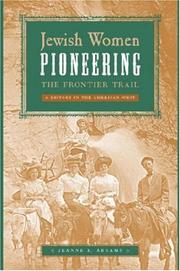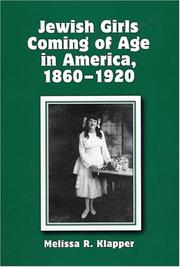| Listing 1 - 5 of 5 |
Sort by
|

ISBN: 0814707734 0814707270 9780814707272 081470719X 9780814707197 9780814707739 9780814707203 0814707203 Year: 2006 Publisher: New York : New York University Press,
Abstract | Keywords | Export | Availability | Bookmark
 Loading...
Loading...Choose an application
- Reference Manager
- EndNote
- RefWorks (Direct export to RefWorks)
The image of the West looms large in the American imagination. Yet the history of American Jewry and particularly of American Jewish women—has been heavily weighted toward the East. Jewish Women Pioneering the Frontier Trail rectifies this omission as the first full book to trace the history and contributions of Jewish women in the American West.In many ways, the Jewish experience in the West was distinct. Given the still-forming social landscape, beginning with the 1848 Gold Rush, Jews were able to integrate more fully into local communities than they had in the East. Jewish women in the West took advantage of the unsettled nature of the region to “open new doors” for themselves in the public sphere in ways often not yet possible elsewhere in the country. Women were crucial to the survival of early communities, and made distinct contributions not only in shaping Jewish communal life but outside the Jewish community as well. Western Jewish women's level of involvement at the vanguard of social welfare and progressive reform, commerce, politics, and higher education and the professions is striking given their relatively small numbers.This engaging work—full of stories from the memoirs and records of Jewish pioneer women—illuminates the pivotal role these women played in settling America's Western frontier.
Judaism --- Women in Judaism --- Jewish women --- Jews --- Religions --- Semites --- Women, Jewish --- Women --- Social conditions. --- History. --- Religion --- Americas. --- Jewish. --- This. --- Western. --- engaging. --- from. --- frontier. --- memoirs. --- pioneer. --- pivotal. --- played. --- records. --- role. --- settling. --- stories. --- these. --- women--illuminates. --- women. --- work--full. --- Women in Judaism.
Book
ISBN: 1782041222 1843838044 Year: 2013 Publisher: Woodbridge, Suffolk : Boydell Press,
Abstract | Keywords | Export | Availability | Bookmark
 Loading...
Loading...Choose an application
- Reference Manager
- EndNote
- RefWorks (Direct export to RefWorks)
This book explores how English legal culture, deeply imbued with the ideas and practices of common law, engaged with the new intellectual, institutional and cultural changes of the Enlightenment. It argues that common law survived as an important part of English legal culture because it was able to meet the various challenges posed by Enlightenment rationalism and civic and commercial discourse. Drawing on works of jurisprudence, legal histories, manuals of law and notebooks of legal practice, and looking in detail at four pivotal, widely-discussed cases, the book illuminates the ways in which common law custom and tradition continued to be valued foundations for the authority of law, even during a period of political change, commercial growth and philosophical rationalism. Exploring the challenges to and adaptations within common law thinking in England in the late seventeenth and early eighteenth centuries, the book reveals that the common law played a much wider role beyond the legal world in shaping Enlightenment concepts. JULIA RUDOLPH is Associate Professor of History at North Carolina State University. She is the author of 'Revolution by Degrees: James Tyrrell and Whig Political Thought in the Late Seventeenth Century' (Palgrave Macmillan, 2002), and of various articles on gender, crime, and the history of the book in early modern England. She has also edited a collection of theoretical and interdisciplinary essays entitled 'History and Nation' (Bucknell University Press, 2006).
Common law --- Enlightenment --- Anglo-American law --- Law, Anglo-American --- Customary law --- History --- English legal culture. --- Enlightenment. --- adaptations. --- authority of law. --- challenges. --- civic discourse. --- commercial discourse. --- commercial growth. --- common law. --- culture. --- jurisprudence. --- legal histories. --- manuals of law. --- notebooks of legal practice. --- philosophical rationalism. --- pivotal cases. --- political change. --- rationalism. --- shaping Enlightenment concepts. --- History.

ISBN: 0814749348 0814748651 1429414251 9781429414258 9780814747803 0814747809 9780814748657 9780814749340 0814748082 Year: 2005 Publisher: New York : New York University Press,
Abstract | Keywords | Export | Availability | Bookmark
 Loading...
Loading...Choose an application
- Reference Manager
- EndNote
- RefWorks (Direct export to RefWorks)
Jewish Girls Coming of Age in America, 1860-1920 draws on a wealth of archival material, much of which has never been published-or even read-to illuminate the ways in which Jewish girls' adolescent experiences reflected larger issues relating to gender, ethnicity, religion, and education. Klapper explores the dual roles girls played as agents of acculturation and guardians of tradition. Their search for an identity as American girls that would not require the abandonment of Jewish tradition and culture mirrored the struggle of their families and communities for integration into American society
Jewish teenagers --- Jewish religious education of girls --- Jewish girls --- Jewish youth --- Teenagers --- Girls --- Religious education of girls, Jewish --- Social life and customs --- Education --- Social conditions --- Jewish religion --- History of North America --- anno 1800-1899 --- anno 1900-1909 --- anno 1910-1919 --- United States --- American. --- Jewish. --- adolescence. --- book. --- brings. --- community. --- development. --- during. --- fascinating. --- figures. --- gender. --- group. --- historical. --- life. --- modern. --- moment. --- neglected. --- pivotal. --- roles. --- United States of America
Book
ISBN: 1282556274 9786612556272 0520944577 9780520944572 6612556277 0520257278 9780520257276 9781282556270 Year: 2009 Publisher: Berkeley : University of California Press,
Abstract | Keywords | Export | Availability | Bookmark
 Loading...
Loading...Choose an application
- Reference Manager
- EndNote
- RefWorks (Direct export to RefWorks)
This pioneering study examines a pivotal period in the history of Europe and the Near East. Spanning the ancient and medieval worlds, it investigates the shared ideal of sacred kingship that emerged in the late Roman and Persian empires. This shared ideal, while often generating conflict during the four centuries of the empires' coexistence (224-642), also drove exchange, especially the means and methods Roman and Persian sovereigns used to project their notions of universal rule: elaborate systems of ritual and their cultures' visual, architectural, and urban environments. Matthew Canepa explores the artistic, ritual, and ideological interactions between Rome and the Iranian world under the Sasanian dynasty, the last great Persian dynasty before Islam. He analyzes how these two hostile systems of sacred universal sovereignty not only coexisted, but fostered cross-cultural exchange and communication despite their undying rivalry. Bridging the traditional divide between classical and Iranian history, this book brings to life the dazzling courts of two global powers that deeply affected the cultures of medieval Europe, Byzantium, Islam, South Asia, and China.
Monarchy --- Rites and ceremonies --- Sassanids --- Social aspects --- Social life and customs. --- Rome --- Iran --- Relations --- Kings and rulers. --- ancient history. --- ancient rome. --- ancient societies. --- ancient world. --- art. --- byzantium. --- china. --- classical heritage. --- classical history. --- court life. --- engaging. --- europe. --- global politics. --- global powers. --- historical. --- iranian history. --- islam. --- kingship. --- medieval europe. --- medieval society. --- medieval times. --- near east. --- nonfiction study. --- persian empire. --- pivotal period. --- political history. --- roman empire. --- rome. --- royal intrigue. --- royalty. --- sacred kingship. --- sasanian iran. --- south asia.
Book
ISBN: 0814786537 0814741320 9780814741320 0814741304 9780814741306 0814741312 9780814741313 9780814786536 9780814741306 9780814741313 Year: 2010 Publisher: New York : New York University Press,
Abstract | Keywords | Export | Availability | Bookmark
 Loading...
Loading...Choose an application
- Reference Manager
- EndNote
- RefWorks (Direct export to RefWorks)
From the patricians of the early republic to post-Reconstruction racial scientists, from fin de siècle progressivist social reformers to post-war sociologists, character, that curiously formable yet equally formidable “stuff,” has had a long and checkered history giving shape to the American national identity.Bodies of Reform reconceives this pivotal category of nineteenth-century literature and culture by charting the development of the concept of “character” in the fictional genres, social reform movements, and political cultures of the United States from the mid-nineteenth to the early-twentieth century. By reading novelists such as Herman Melville, Mark Twain, Pauline Hopkins, and Charlotte Perkins Gilman alongside a diverse collection of texts concerned with the mission of building character, including child-rearing guides, muscle-building magazines, libel and naturalization law, Scout handbooks, and success manuals, James B. Salazar uncovers how the cultural practices of representing character operated in tandem with the character-building strategies of social reformers. His innovative reading of this archive offers a radical revision of this defining category in U.S. literature and culture, arguing that character was the keystone of a cultural politics of embodiment, a politics that played a critical role in determining-and contesting-the social mobility, political authority, and cultural meaning of the raced and gendered body.
Politics and literature --- Political culture --- Rhetoric --- Character --- National characteristics, American, in literature. --- Characters and characteristics in literature. --- Character in literature. --- American fiction --- Language and languages --- Speaking --- Authorship --- Expression --- Literary style --- Ethology --- Ethics --- Personality --- Character sketches --- Characterization (Literature) --- Literary characters --- Literary portraits --- Portraits, Literary --- History --- Political aspects --- History and criticism. --- History and criticism --- 19th century --- Characters and characteristics in literature --- National characteristics [American ] in literature --- United States --- Twain, Mark --- Characters --- Gilman, Charlotte Perkins --- Criticism and interpretation --- Hopkins, Pauline Elizabeth --- Addams, Jane --- Bodies. --- States. --- United. --- category. --- century. --- character. --- charting. --- concept. --- culture. --- cultures. --- development. --- early-twentieth. --- fictional. --- from. --- genres. --- literature. --- mid-nineteenth. --- movements. --- nineteenth-century. --- pivotal. --- political. --- reconceives. --- reform. --- social. --- this.
| Listing 1 - 5 of 5 |
Sort by
|

 Search
Search Feedback
Feedback About UniCat
About UniCat  Help
Help News
News